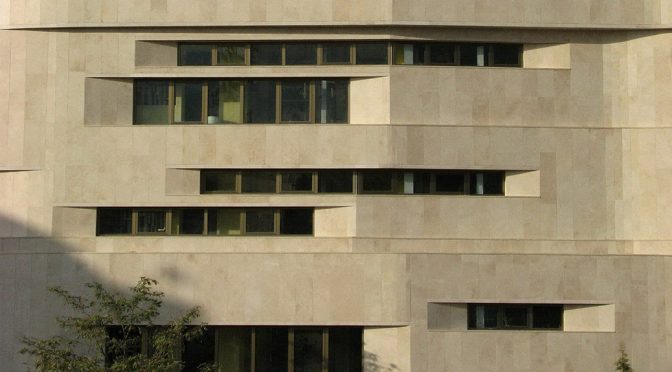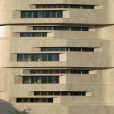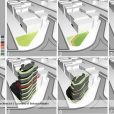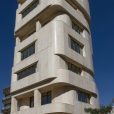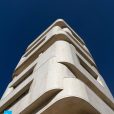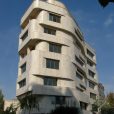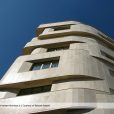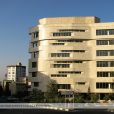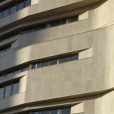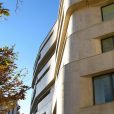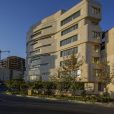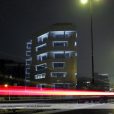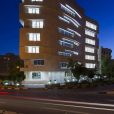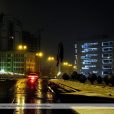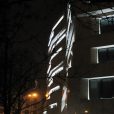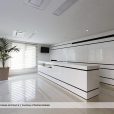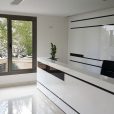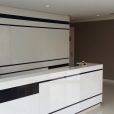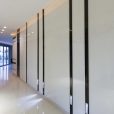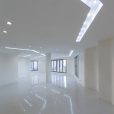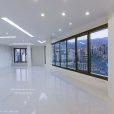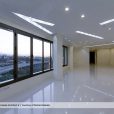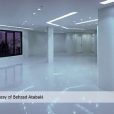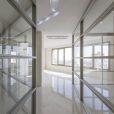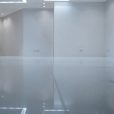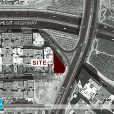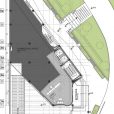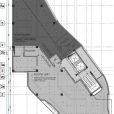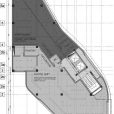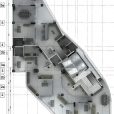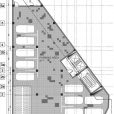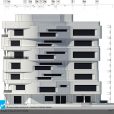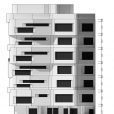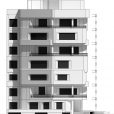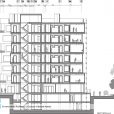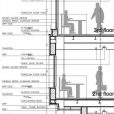ساختمان اداری نیایش
بهزاد اتابکی
موقعیت: تهران، ایران
تاریخ: ۱۳۹۲
مساحت: ۳۲۵۸ مترمربع
وضعیت: ساختهشده
کارفرما: رضا فرحبخش
تیم پروژه: سهیل کرجانی، ساینا افشار، حامد سرحدی، بهناز اتابکی، محمدرضا بادله، آرزو زارعدار
عکس: پرهام تقیاف، بهزاد اتابکی
ساختمان اداری نیایش، نبش یک تقاطع غیرهمسطح پرتردد (اتوبان نیایش و بلوار فرهنگ سعادتآباد) و در زمینی تقریبا مثلثیشکل قرار گرفته است. بخش مهمی از تلاش طراح بر این بوده است که در روند خلق فرم، از بازنمایی شکل نامناسب زمین پرهیز شود. از سوی دیگر، با توجه به بالابودن انرژی حرکتی در اطراف سایت و همچنین قابل رویت بودن بنا از دو مسیر پرتردد (حتی از درون اتومبیلهای با سرعت بالا)، ایده اولیه خطوط نما پدیدار شد. به مانند تصویربرداری از جسمی پرسرعت که در حرکتی سریع، تنها خطوطی کشیده و گاه مواج از خود به جا میگذارد، لبهها با حرکتی نرم، سطوح اصلی نما را به هم پیوند دادهاند و مرز بین نمای شمالی، شرقی و جنوبی را محو کردهاند و هرچه بیشتر، به آزادشدن و روانی فرمها در سطوحی افقی کمک کردهاند.
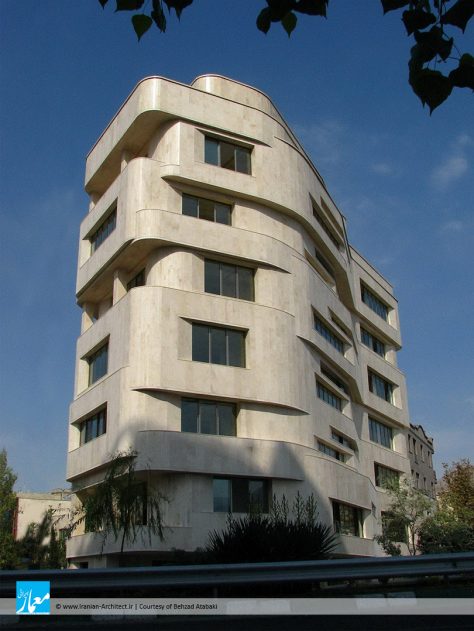
تاکید روی این خطوط و همچنین، حرکت آزاد و تکرار نه چندان یکسان طبقات با پوششی تکمصالحی و تکرنگ، در طراحی نورپردازی خارجی بنا نیز مورد توجه قرار گرفت و به منظور قابل درک بودن حجم کلی بنا و ایدههای مترتب بر طرح معماری در شبهنگام، با برداشت از تیرگی سایههای پدیدآمده از آفتاب روز، بخشهایی از حجم بنا انتخاب و با LED نواری، نورپردازی شد، به شکلی که منابع نور، خود به طور مستقیم به چشم نیایند، ولی در عوض، برای نگهداری، تعویض یا تعمیر، به آسانی در دسترس باشند.
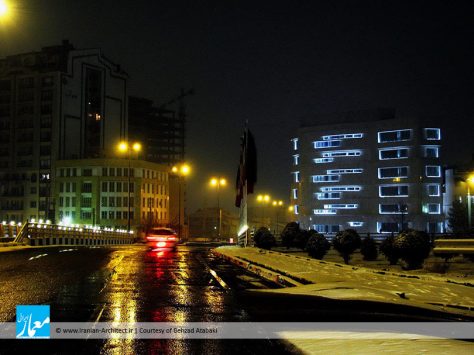
فضاهای داخلی نیز در ادامه همان ایده بازنمایی آزادی و روانی فضاها قرار دارند. واحدها بر اساس نظام پلان باز اداری طراحی شدهاند، به صورتی که بر حسب نیاز استفادهکنندگان هر واحد، تنها با ایجاد پارتیشنهایی که در جهت کاربری فضاها و بر پایه طرح پیشنهادی معمار، تعریف میشوند، تقسیمبندی خواهند شد. در این فضاها سعی شده است با استفاده از پنجرههایی وسیع، امکان استفاده از نور روز و همچنین چشماندازهای زیبایی از شهر، کوه و آسمان فراهم شود.
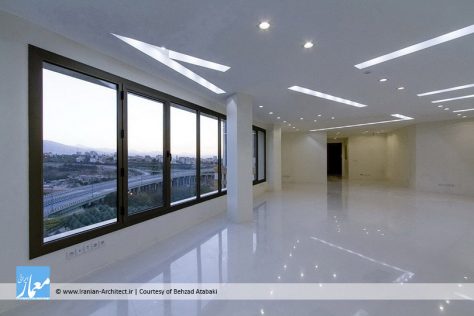
از خطوط بیرونی بنا، خطوطی سادهتر و آرامتر به درون واحدها نفوذ کرده و بر روی سقفها، به شکل شکافهای نور پدید آمده است که به همراه دیگر نورهای نقطهای تعبیهشده در سقف، تامینکننده نور واحدها هستند؛ این نورها نیز بر اساس ایدههای معماری ذکرشده در بالا و نیز قرارگیری پارتیشنهای داخلی شکل گرفتهاند. نورپردازی داخلی به همراه رنگ روشن و سفید دیوارها، کف و سقفها نیز در ادامه ایده تکمصالحی و یکپارچگی بنا قرار دارد.
Niayesh Office Building
Behzad Atabaki
Location: Tehran, Iran
Date: 2013
Area: 3,258 sqm
Status: Completed
Client: Reza Farahbakhsh
Project Team: Soheil Korjani, Sayna Afshar, Hamed Sarhadi, Behnaz Atabaki, Mohammadreza Badeleh, Arezou Zaredar
Photo: Parham Taghioff, Behzad Atabaki
Niayesh Office Building overlooks a busy expressway in Tehran and is set on a disproportionate semi-triangular plot of land. The main objective in the design was to create a form that would not reflect this disproportion. The building’s identity also takes cue from the high level of kinetic energy surrounding the site in that it resembles a photographic image of a fast moving object that is seen as stretched (and sometimes) wavelike lines. All this provides the building with free floating lines that run all around it and connect the north-south orientation very smoothly avoiding any sharp angles and giving it aesthetic consistency on every level.
The central concept behind the design was to set the layers free from a monotonous repetition or other structural confinements. Here, each layer moves independently from the one on top or the other below. The floor layers, while not exactly similar, build up in a free manner and take on a light single-material stone-cover to create a harmonic and a homogenous identity / quality for the building. In the sunlight, dark shades are drawn over these monochrome shapes which make the lines take on a more horizontal characteristic. This characteristic is further highlighted by the height of the building, in proportion to its area (seven floors on the ground). The windows, further define this concept, where some are again stretched alongside the building as they mean to help the eye glide around it.
The interior moves along the same concept of spatial smoothness and flow. The units have been designed based on open office system and may be partitioned according to their desired functions. In order to benefit from the daylight and the fascinating views of the city, mountains and the sky, large windows have been installed.
Exterior lines flow into the interior in a calmer softer way, and then onto the ceiling where they have formed track of lights and together with other lighting, designed in the ceiling that provide the lighting at night. The bright white color of the walls, the floor, and the ceiling reflects the same concept of the mono-material and harmonic façade.

